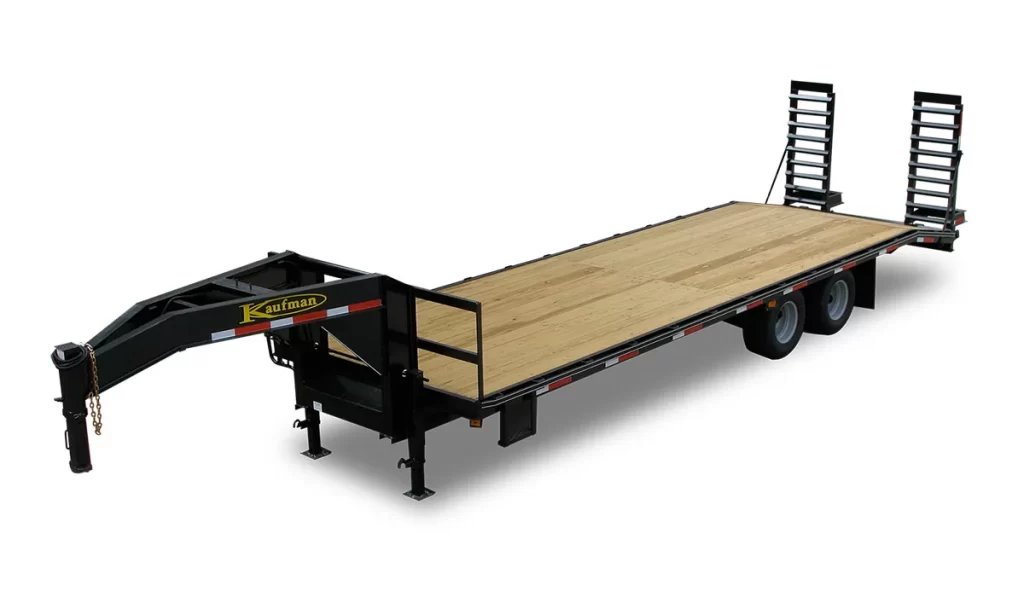Why You Should Buy a Kaufman Gooseneck Trailer
When it comes to hauling heavy loads, reliability, durability, and versatility are key factors to consider. Whether you’re in the construction industry, farming, or need to transport equipment, a gooseneck trailer offers the strength and stability required for the job.
Kaufman Trailers has established itself as a leader in the industry, known for producing high-quality gooseneck trailers that meet the demands of various industries. Join our gooseneck trailer manufacturers as we explore why investing in one of our top-quality gooseneck trailers is a smart choice for anyone needing a dependable and robust trailer solution.
Why Choose a Gooseneck Trailer?
Gooseneck trailers are made specifically to hook to a ball in the center of a pickup truck bed.
There are two significant advantages to this type of hitch on a gooseneck trailer:
- The truck can carry much more weight with the load centered over the truck axle than it can with the load attached to the back of the truck.
- A gooseneck hitch provides more stability and safety due to the fact that the weight of the hitch is carried from the middle of the truck bed.
This increased tongue load carried in the bed allows the gooseneck trailer to be towed with an increased safety and stability factor compared to a bumper pull trailer. The likelihood of the trailer ever “whipping” is greatly reduced with a gooseneck hitch.
Gooseneck Trailer Hitches
There are several fundamentally different types of hitch connections for utility trailers, flatbed trailers, and equipment trailers. These include ball coupler, pintle ring, kingpin, and gooseneck ball attaching mechanisms.
There are several different types of hitch kits on the market to outfit your pickup to pull a gooseneck trailer. Some of today’s 1-ton pickups can also be ordered from the factory with the gooseneck mount already installed to the frame under the bed. You simply purchase the slide-in ball kit from the dealers parts department. We use several 1-ton trucks to deliver trailers and have B & W gooseneck hitches installed in these trucks. This is a great set up.
Setting Up Your Gooseneck Trailer Hitch
You can pull a rod under the bed of your gooseneck trailer and slip the ball out of its housing, turn it over, and drop it back in the housing. The ball is still with the truck but there is nothing sticking up from the bed.
At Kaufman Trailers, we often send our customers to Hitch Crafter, a local trailer hitch and towing equipment company, which is only a couple miles from our North Carolina plant. This way, customers can have this setup installed on their truck by industry professionals. There are many other fine setups available from other companies that you can find on the web.
Gooseneck Trailer Frames
There are two types of frame construction utilized to build a flatbed deck-over gooseneck trailer.
Stacked Frame Construction
In a stacked frame configuration, the cross members are welded to the top of the mainframe beams with outer rails, then stake pockets, then the rub rail on the very outside stake pockets.
Pieced Beam Construction
Pieced beam construction is the favored and superior way to build a heavy-duty flatbed gooseneck trailer. We use this method on many of our heavy-duty Deluxe flatbed goosenecks. In this method of building the trailer, the mainframe beams are “pierced” or cut to the shape of the channel crossmembers. The cross members slide through the piercings in the main beams and the entire structure is welded back together into one unit.
This makes a super strong and durable frame. You can easily identify a pierced beam frame by looking at the top of the floor—you will see the tops of the mainframe beams running the full length of the floor.
Style Options for Gooseneck Trailers
Kaufman brand gooseneck trailers are offered in a wide variety of styles. Basically, almost any Kaufman trailer that is offered in a bumper pull or pintle ring version can also be purchased in a gooseneck trailer version. This includes our landscape utility trailers, car trailers, and our fender equipment trailer line.
Consumers Choice: The Flatbed Gooseneck Trailer
By far our most popular gooseneck trailer line is the flatbed trailer lineup.
This product line starts with our lighter duty model that is equipped with two 7,000 lb. axles and an 8 in. I-beam frame. This trailer has the 8’ wide deck over the wheels with a 20’ flatbed and 4’ dovetail.
Stake pockets with rub rail down the outside of the bed bring the overall width to just under 102”. Progressive capacity ratings add larger frames along with increased axle capacities. Three 7,000 lb. axles, two 10,000 lb. dual wheel axles, or three 10,000 lb. dual wheel axles are some of the available running gear combinations.
Why Choose Kaufman Trailers?
Kaufman Trailers is renowned for delivering top-quality gooseneck trailers that are built to last and meet the demands of various industries.
Here’s why Kaufman should be your go-to choice:
- Superior craftsmanship
- High-quality materials
- Competitive pricing
- Excellent customer support
- Wide range of options
Contact Our Gooseneck Trailer Experts Today
Need more questions answered about a gooseneck trailer? Want our expert advice? Our experts at Kaufman Trailers are here to help you every step of the way. Whether you have questions about gooseneck trailers or need guidance on selecting the right trailer, we’re just a call or click away.
Give us a call today at 866-455-7444 or get started by filling out our online contact form below.
 Kaufman Trailers
Kaufman Trailers
